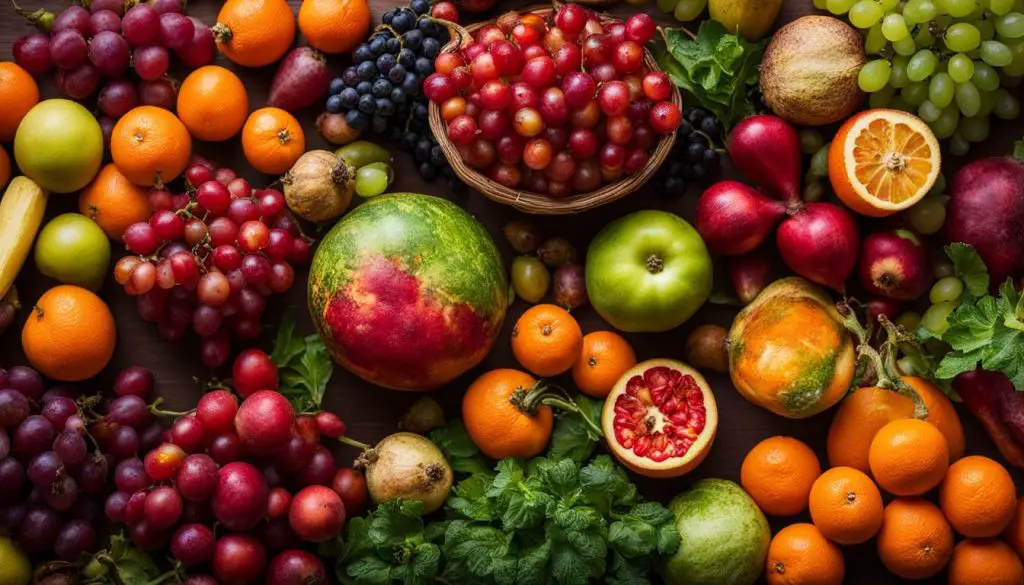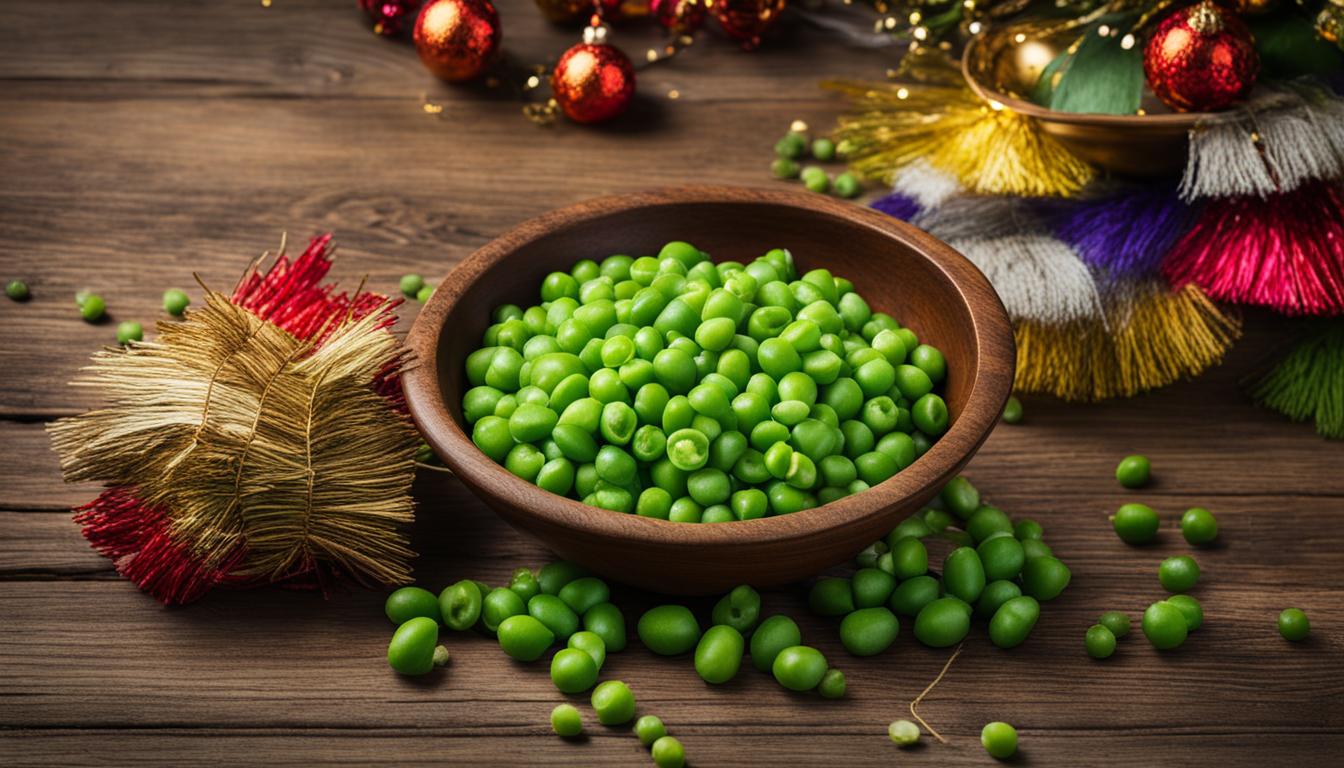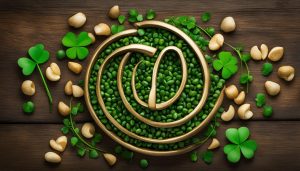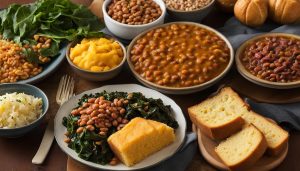Welcome to our article exploring the fascinating tradition of eating green peas for good luck on New Year’s Day! If you’ve ever wondered about the origins and symbolism behind this popular tradition, you’ve come to the right place. Join us as we delve into the history and significance of this beloved New Year’s tradition.
Contents
- 1 The Origins of the Tradition
- 2 The Symbolism of Greens and Pork
- 3 The Significance of Cornbread
- 4 Other Traditional New Year’s Foods
- 5 Conclusion
- 6 FAQ
- 6.1 Can I eat green peas for good luck on New Year’s?
- 6.2 What is the origin of the tradition of eating black-eyed peas on New Year’s Day?
- 6.3 Why are greens and pork considered lucky foods for New Year’s?
- 6.4 What is the symbolism of cornbread on New Year’s?
- 6.5 What are some other traditional New Year’s foods that are believed to bring luck?
- 6.6 Can following these traditions guarantee good luck and prosperity?
- 7 Source Links
Key Takeaways:
- Eating black-eyed peas on New Year’s Day is a long-held tradition in the South, believed to bring good luck.
- Collard greens, cornbread, and tomatoes are often served alongside peas to symbolize wealth and health.
- The tradition of eating black-eyed peas has origins in African, Jewish, and Southern cultures.
- Greens and pork are also eaten on New Year’s Day for luck and prosperity.
- Cornbread is believed to bring good fortune and is a staple in Southern cuisine.
The Origins of the Tradition
The tradition of eating black-eyed peas on New Year’s Day has its origins in various cultures and historical events. During the Civil War, when Union soldiers raided the Confederate army’s food supply, they left behind only black-eyed peas. These peas became a staple for newly-freed enslaved people, who integrated them into their diets out of necessity.
In Jewish culture, black-eyed peas have been eaten as part of the Rosh Hashanah holiday for centuries. The African influence on this tradition can be seen in the Carolinas, where rice dishes simmered with chicken or shrimp, known as pilaus, were popular. When black-eyed peas were added to these dishes, they became known as Hoppin’ John, a dish that symbolizes good luck and prosperity for the new year.
Over time, the tradition of eating black-eyed peas on New Year’s Day has evolved and spread, becoming a symbol of luck and prosperity for many cultures. The superstition associated with these peas stems from their historical significance and their association with resilience and hope in the face of adversity. Today, this tradition continues to be celebrated and enjoyed by many as a way to bring luck and good fortune in the new year.
Table: Origins of the New Year’s Food Tradition
| Culture/Event | Origin |
|---|---|
| Civil War | Black-eyed peas became a staple for newly-freed enslaved people. |
| Jewish Culture | Black-eyed peas have been eaten as part of Rosh Hashanah. |
| African Influence | Black-eyed peas were added to rice dishes, becoming Hoppin’ John. |
The origins of the New Year’s food tradition highlight the cultural significance and historical context behind the consumption of black-eyed peas. Understanding these origins adds depth and meaning to the tradition, making it more than just a superstition or superstition but rather a celebration of resilience and hope for a prosperous new year.
“The tradition of eating black-eyed peas on New Year’s Day has its roots in various cultures and historical events. It is a symbol of resilience and hope for a prosperous new year.”
The Symbolism of Greens and Pork
In addition to eating black-eyed peas for good luck on New Year’s Day, consuming greens and pork is also believed to bring luck and prosperity for the year ahead. Greens, such as collard greens, kale, and chard, are associated with money and financial well-being. The tradition of eating greens on New Year’s stems from the belief that the color green represents wealth. Therefore, by including greens in your New Year’s meal, you are symbolically inviting financial prosperity into your life.
Similarly, pork, especially ham, is considered lucky because of the way pigs root forward while eating. This rooting motion signifies progress and moving forward in the new year. By partaking in pork dishes, you are embracing the idea of moving forward and making positive strides in your life. Pork is seen as a symbol of good luck and is often included in New Year’s meals to bring forth prosperity and abundance.
| Lucky Foods for New Year’s | Symbolism |
|---|---|
| Black-eyed peas | Good luck |
| Greens (collard greens, kale, chard) | Wealth and financial prosperity |
| Pork (ham) | Progress and moving forward |
The combination of eating black-eyed peas, greens, and pork on New Year’s Day is believed to set a positive tone for the year ahead, inviting luck and prosperity into your life. These traditions have withstood the test of time and continue to be observed in many cultures and households today. So, make sure to include these symbolic foods in your New Year’s Day celebration and embrace the opportunity for good fortune in the coming year.
The Significance of Cornbread
Cornbread holds a special place in the New Year’s Day menu, complementing the traditional dishes of black-eyed peas and greens. Its golden color and round shape symbolize wealth and coins, making it a fitting addition to the auspicious meal. Considered a staple in Southern cuisine, cornbread is believed to bring good fortune and prosperity in the new year.
When served alongside black-eyed peas and greens, cornbread completes a traditional and lucky New Year’s meal. Whether enjoyed with butter or honey, cornbread adds a delightful touch to the festivities and contributes to the overall symbolism of wealth and abundance.
The Cornbread Recipe
If you’d like to incorporate cornbread into your New Year’s Day celebration, here’s a simple and delicious recipe to try:
- Preheat your oven to 425°F (220°C) and grease a 9-inch (23 cm) round baking pan.
- In a large bowl, combine 1 cup (120 grams) of cornmeal, 1 cup (125 grams) of all-purpose flour, 1/4 cup (50 grams) of granulated sugar, 1 tablespoon (15 grams) of baking powder, and 1/2 teaspoon (2.5 grams) of salt.
- In a separate bowl, whisk together 1 cup (240 milliliters) of buttermilk, 1/3 cup (80 milliliters) of vegetable oil, and 2 large eggs.
- Pour the wet ingredients into the dry ingredients and stir until just combined.
- Pour the batter into the prepared baking pan and smooth the top.
- Bake for 20-25 minutes or until the top is golden and a toothpick inserted into the center comes out clean.
- Allow the cornbread to cool for a few minutes before cutting into wedges and serving.
Now you’re ready to enjoy a delicious and symbolic New Year’s meal with the perfect addition of cornbread. May it bring you luck, prosperity, and a taste of Southern tradition!
Other Traditional New Year’s Foods
Aside from black-eyed peas, greens, and cornbread, there are several other traditional foods that are eaten on New Year’s Day for good luck and prosperity. These foods have their own symbolic meanings and are believed to bring blessings and abundance for the year ahead.
Lentils
New Year’s food traditions often vary across different cultures, and in Italian households, lentils are a popular choice for New Year’s Eve. These tiny legumes resemble coins and are believed to attract prosperity and financial success. Lentils are often prepared in dishes like lentil soup or sautéed with vegetables, offering a hearty and nutritious start to the year.
Rice
In many Asian cultures, rice holds great significance and is associated with luck and good fortune. It symbolizes abundance and prosperity, making it a staple on New Year’s Day. Rice dishes such as fried rice or steamed rice are often enjoyed to ensure a prosperous year filled with blessings and ample food.
Oranges, Grapes, and Pomegranates
Fruits are also considered lucky foods for the new year due to their symbolic meanings. Oranges, with their vibrant color, represent wealth and prosperity. Grapes are believed to bring good luck and are often consumed at the stroke of midnight on New Year’s Eve. Pomegranates, with their many seeds, are seen as a symbol of abundance, fertility, and good fortune.
| Food | Symbolic Meaning |
|---|---|
| Lentils | Attracting prosperity and financial success |
| Rice | Symbol of abundance and prosperity |
| Oranges | Representing wealth and prosperity |
| Grapes | Bringing good luck |
| Pomegranates | Symbolizing abundance, fertility, and good fortune |
These traditional foods, along with black-eyed peas, greens, and cornbread, are all part of diverse New Year’s food traditions around the world. Whether you believe in the luck they bring or simply enjoy their flavors and significance, incorporating these foods into your New Year’s Day celebration can add a touch of tradition and positivity to the start of the year.

Conclusion
The tradition of eating black-eyed peas, greens, pork, cornbread, and other lucky foods on New Year’s Day has deep roots in various cultures and superstitions. These foods are believed to bring luck, prosperity, and good fortune in the new year.
Whether you follow these traditions for their symbolic meanings or simply enjoy the delicious flavors of these traditional dishes, incorporating them into your New Year’s Day meal can add a touch of festive tradition and positive vibes for the year ahead.
So, why not start the year with a plate filled with good luck and delicious food? Embrace the new year with the belief in new year’s good luck charms and enjoy the bountiful flavors of the new year’s lucky food.
FAQ
Can I eat green peas for good luck on New Year’s?
While green peas are not traditionally associated with good luck on New Year’s, black-eyed peas are believed to bring good luck. Green peas are a different variety and are not typically included in the traditional New Year’s meal for luck and prosperity.
What is the origin of the tradition of eating black-eyed peas on New Year’s Day?
The tradition of eating black-eyed peas on New Year’s Day has various origins. It can be traced back to the Civil War, where black-eyed peas became a staple for newly-freed enslaved people after Union soldiers raided the Confederate army’s food supply. Black-eyed peas have also been part of the Rosh Hashanah holiday in Jewish culture for centuries. Additionally, the African origin of the tradition can be traced to rice dishes simmered with chicken or shrimp, which were popular in the Carolinas.
Why are greens and pork considered lucky foods for New Year’s?
Greens, such as collard greens, kale, and chard, are believed to symbolize money and financial prosperity. The tradition of eating greens on New Year’s is rooted in the belief that the color green represents wealth. Pork, especially ham, is considered lucky because of the way pigs root forward, which signifies progress and moving forward in the new year. Both greens and pork are believed to bring luck and prosperity to those who consume them on New Year’s Day.
What is the symbolism of cornbread on New Year’s?
Cornbread is often served alongside black-eyed peas and greens on New Year’s Day. The golden color and round shape of cornbread symbolize wealth and coins, making it a fitting addition to the New Year’s meal. Cornbread is believed to bring good fortune and prosperity in the new year. It is often served with butter or honey and is a staple in Southern cuisine.
What are some other traditional New Year’s foods that are believed to bring luck?
In addition to black-eyed peas, greens, and cornbread, there are other foods associated with good luck on New Year’s Day. Ring-shaped items, such as doughnuts, symbolize the coming full circle of the year and are believed to bring good luck. Lentils, which resemble coins, are eaten in Italian households on New Year’s Eve to attract prosperity. Rice is a staple in Asian cultures and is associated with prosperity and good luck. Oranges, grapes, and pomegranates are also considered lucky fruits for the new year due to their symbolic meanings of wealth, abundance, and fertility.
Can following these traditions guarantee good luck and prosperity?
While following these traditions can add a touch of festive tradition and positive vibes for the year ahead, luck and prosperity are ultimately influenced by various factors. These traditions are rooted in cultural beliefs and superstitions, and while they may not guarantee good luck, they can be a fun way to celebrate the new year and enjoy delicious food.





